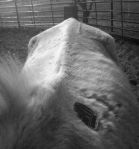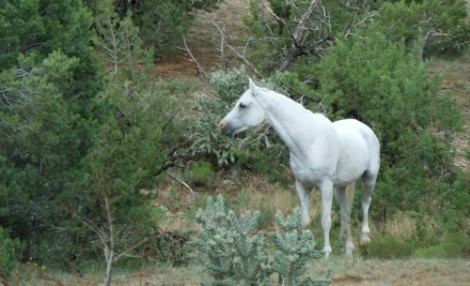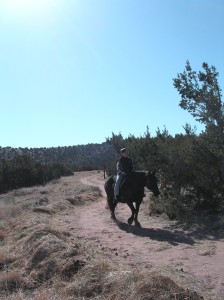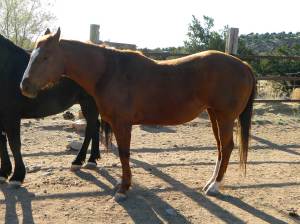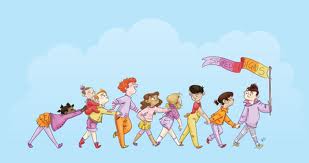 Thank you so much for following this blog about animals and animal communication! I wanted to let you know, however, that I have moved the entire blog to my main website and that is where new posts appear. I hope you will hop on over there to catch up and sign up to follow me at that location. And if you have a blog too, please put that in the comments there so I can check it out. Thanks so much!
Thank you so much for following this blog about animals and animal communication! I wanted to let you know, however, that I have moved the entire blog to my main website and that is where new posts appear. I hope you will hop on over there to catch up and sign up to follow me at that location. And if you have a blog too, please put that in the comments there so I can check it out. Thanks so much! 
Archive for Horsin’ Around
Hello, Blog Followers!
Blotched, Botched, or Blessed? One Indian Pony’s Amazing Journey
Lucky was named Lucky because he was dumped in the desert on the Mexican border seven months ago with about 40 other half-dead horses. How this could possibly be “lucky” sounds like a mystery, I know, but had his trailer-load of horses bound for slaughter in Mexico crossed that border, what little meat there was left on Lucky’s emaciated body would now most likely be digesting in the gut of some person in France… or flowing along the rivers of waste below the city of Paris. A noble equine life wasted.
The horses were dumped because several had a disease known as strangles, which can be a death sentence for horses, is highly contagious, and is certainly not acceptable for animals intended for human consumption. It was no doubt far cheaper for the hauler to release them into the desert than to try to sell them or park them somewhere.
We don’t know the whole story, and surely many of these horses perished, but Lucky was picked out of the herd in a holding pen by a teenage girl as a “gift” from a benefactor who often rescued some of these poor critters.
This girl herself had a rare gift with horses,  and she must have seen some spark in the eye of this little horse the day she chose him,
and she must have seen some spark in the eye of this little horse the day she chose him, ![]() even though that “eye” reflected such poor health and resignation.
even though that “eye” reflected such poor health and resignation.
Supposedly Lucky was only six, so that was in his favor. And he didn’t have strangles, so that was a double-plus. So off he went for rescue and rehab at the girl’s family’s stables, where they regularly took in as many of his kind as possible, brought them back to life, and placed them in good homes.
Fast forward to July of 2012 when Lucky arrived in Nambe, New Mexico, just north of Santa Fe, and was picked up by his new owner, my dear friend Cindy. Cindy had been looking for an appropriate companion for her only-horse, Nova, and, once again, there was just something about Lucky’s pictures that made her staunchly committed to giving him a permanent, forever home. He had been through months of rehab with his rescuers, Cindy’s friends, and had even recently survived a life-threatening round of severe colic. But Cindy never waivered. She was absolutely, positively sure that he was the one for her and her four-year-old mare, Nova.
Cindy began researching the little guy, posted pictures of the strange markings on his left side, and thereby learned much about his probable heritage.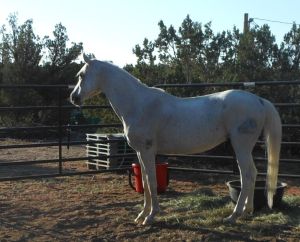 She found out that these marks are known as “blotch brands” and are Navajo in origin. (Cindy says they should be called botched brands because they are so messed up–no doubt due to improperly restraining the horse during branding.) The hip brand traditionally has three overlaid images which reflect the tribe, the land, and the family of the horse, so it’s easy to see how that brand alone could easily be “smeared” and hard to read. There are also often many other smaller markings/blotch-brands on a Navajo pony, of which Lucky has at least two, one of which looks like a face.
She found out that these marks are known as “blotch brands” and are Navajo in origin. (Cindy says they should be called botched brands because they are so messed up–no doubt due to improperly restraining the horse during branding.) The hip brand traditionally has three overlaid images which reflect the tribe, the land, and the family of the horse, so it’s easy to see how that brand alone could easily be “smeared” and hard to read. There are also often many other smaller markings/blotch-brands on a Navajo pony, of which Lucky has at least two, one of which looks like a face.
One Navajo horse trainer offered further description: “If you can ride him bareback with a halter, and he can’t back up, then he’s off the Navajo Reservation.” Later, responding to Cindy’s horrified message that this horse had been sold for slaughter, probably for $100 or less, he said, “You haven’t seen poor until you’ve been on the rez.”
Due to the drought, hay prices, and the economy, horses are being given away, sold for slaughter, or just turned loose these days by folks who are far more prosperous than those on the rez, so no, it is no wonder that Lucky ended up on that truck bound for Mexico. Still, I like to imagine little children on him, riding bareback with just a halter, and that his family was bereft to give him up. But that $100 sale price to them probably meant at least a few months of staples for their larder. It’s hard for any of us reading this to relate to that, but it certainly is a fact of life for many, and definitely for many of those among the Native American population of our country.
So Lucky lucked out and finally made it “home,” just one week ago. He was shaking all over as we started to unload him, but when he stepped out of the trailer, all of that went away and one could feel a total sea change in his being: he KNEW. We humans have epiphanous moments, why shouldn’t the animals? We could feel Lucky registering that this was his home, forever. It felt familiar being back in the high desert of New Mexico, and he immediately went into a place of total trust, relaxation and appreciation for the patient woman who stood murmuring quietly by his side.
In the last seven days, Lucky has flourished. He is on ten acres with one to two hours of at-liberty time each day to move freely, test the legs he hasn’t had a chance to use in a long, long time, and to graze on familiar stubbly, native desert grasses. But he also has his own pen with plenty of hay and feed. He is so thankful for this bounty that he went back into his pen, unprompted, all by himself, the first day he was turned out, after only an hour and a half. And he glues himself to Cindy whenever she is with him, following her from chore to chore, muck to muck. He knows. He had an epiphany. He understands and is grateful.
Other things Cindy has learned: Many of the rez horses date back to the original Arabian breed of ancient lore—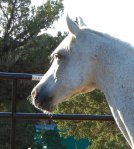 the type that slept in tents with the Bedouins. A rare type these days because they are so calm and devoted, not as “hot” as many of their modern-day counterparts. Considering Lucky’s head, conformation, size and disposition, he certainly fits this mold. According to her vet, he is 11 years old, not six, which is just fine with her and will only help stabilize her four-year-old filly’s adolescent ways. And he has a spirit that can survive things most of us don’t even want to think about.
the type that slept in tents with the Bedouins. A rare type these days because they are so calm and devoted, not as “hot” as many of their modern-day counterparts. Considering Lucky’s head, conformation, size and disposition, he certainly fits this mold. According to her vet, he is 11 years old, not six, which is just fine with her and will only help stabilize her four-year-old filly’s adolescent ways. And he has a spirit that can survive things most of us don’t even want to think about.
Lucky has been renamed “Sharif” (pronounced “Shar-EEF”) honoring all the traits he bears from his long-distant ancestry: nobility, honor, gentleness. He still needs to gain more weight and rebuild muscle, but no doubt one day soon Cindy will be able to find out if he can be ridden “bareback, with just a halter” (though by then she will have taught him to back up!).
Sharif is one of the lucky ones. So many horses, dogs and cats are being discarded these days due to lack of resources to take care of them. I hope Sharif’s story will inspire others like Cindy to step up and rescue or sponsor just one animal who would otherwise be lost. In this case, I don’t know who lucked out the most: Sharif or Cindy. She agrees.
The Mustang Trail Horse
Here’s my theory: If you have a horse who was living wild on the land before he was captured, then you have a horse who is not afraid of going out on the trail.
As any horse person knows, there are horses who are just nuts if taken out of an enclosed environment. They aren’t used to open spaces, and they’ve never been exposed to them. This is a great disappointment to many a horse owner who envisions him or herself galloping across the prairie on a noble steed.
I once had a client who decided to get back into horses after many years of “abstinance.” She shopped long and hard for just the right horse and was drawn to a beautiful Palomino at a show barn. He was a mature fellow with cool blood–not a hot breed–and had lots of training under his belt. Perfect! Or so it seemed.
Things went swimmingly for the first few months as they got to know each other, schooling and taking lessons in the arena of the barn where he was boarded. The client then decided it was time to go out on the trail. NO WAY, her beautiful boy let her know in no uncertain terms! Turned out, as nicely trained as he was, he had no trail experience.
I was called in to talk to the horse and explain to him that he would always be safe with his person, my client, and that he didn’t need to be afraid. She wanted me to tell and show him long, lazy, enjoyable trail rides together where he was completely calm.
Unfortunately it doesn’t work this way. Just because we can “talk” to an animal doesn’t mean we can reason them out of an instinctive fear or behavior. And this boy made it as clear to me as he had to his owner that he had no intention of trail riding! Try as I might, I couldn’t really make her understand this, so I fear she may have been disappointed with our session. Be that as it may…….
The point being, if you want a good solid trail horse you might just look around for a mature, well-started Mustang. They are used to being out, they know their way around, and they are surefooted and savvy. In fact, they do often have strong opinions about where they want to go and what they want to do, independent of yours, so don’t expect a trail buddy who’s like a horse from a dude string.
So pick a Mustang, honor one of our country’s greatest icons, and be ready for the ride!
*******************************************************************************************************************
If your curious or crazy about Mustangs, you might enjoy some of the following posts:
Mustangs Come in All Sizes, Shapes, Colors, and……… yes, Personalities
A Very Different Type of Mustang Personality
The More, Ahem, “Robust” Type of Mustang
How Are Wild-Captured Mustangs Different From Our Domesticated Breeds?
Quick Tips On Your Horse’s Personality Type
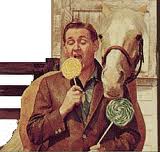 “A horse is a horse, of course, of course…,” Mr. Ed sang for his theme song, but did he fit the average horse mold? Not on your life!
“A horse is a horse, of course, of course…,” Mr. Ed sang for his theme song, but did he fit the average horse mold? Not on your life!
Horses have as diverse personalities as we humans do, and being able to identify them can really help you find your horse-match made in Heaven. One ingenious personality typing system, devised by equine veterinarian, Dr. Madalyn Ward, can be studied in her book, Horse Harmony – Understanding Horse Types & Temperaments. And you can test your horse (and yourself) for free on her site in order to see if the two of you are a good match. Dr. Ward’s system is based on ancient Traditional Chinese Medicine, which breaks down constitutional types into 11 different groups, each of which is unique in terms of what kind of nutrition, activity, training/learning methods, etc. suit it best.
Intrigued? Here are a few quick clues on identifying the personality type that best fits your horse. These are excerpted from Dr. Ward’s most recent newsletter, with permission. If you like what you see here, visit the site, take the test, and, better yet, buy the book to read about your horse’s type in depth.
Horse Temperament: 11 Quirks for 11 TypesWe list 11 quirks below, one associated with each horse temperament type. Scan through the list and see if any of these quirks rings a bell. This will help you determine your horse’s temperament type, especially if you are straddling the fence between two types!Fire: Often rolls the tongue or flaps the lips, especially when younger or under stress.Earth: When happy, often gives a contented sigh and carries an air of calm and peace.Water: When balanced, has the keen look of the eagle and is one of the most regal-looking types.Metal: Thrilled to do his job as soon as he learns it. Does a trademark grimace with his mouth when he can’t figure out his job.Wood: Loves to break things. If every gate, post, and horse toy on your place is busted or bent, you’re horse is a Wood!Shao Yang (Fire/Wood): Dislikes being touched, especially on the feet or toward the hind end.Jue Yin (Wood/Fire): Causes trouble in a playful way … loves to mess with you!Tai Yang (Water/Fire): Exuberant and loves to move … the happier he is, the faster he moves, ears pricked and exuberant! Why walk when you can trot? Why trot when you can canter?Shao Yin (Fire/Water): The most affectionate type, likely to nudge you, loving, innocent.Yang Ming (Metal/Earth): Willing to please, not very spontaneous (will give lots of warning before bucking or shying or causing trouble).Tai Yin (Earth/Metal): Very dedicated to one person, to the point of happily doing just about anything for the person they love, even if the task is difficult. Will perform for others, but not eagerly.Horse Temperament: Quirks Ring a Bell?Hopefully the above list of quirks will help you more easily determine your horse’s temperament type. Sometimes it’s the little things that our horses do that make them stand out as one horse temperament type or another.
How to Diagnose Horse Ulcers
This is a SUPER video on diagnosing whether or not your horse has ulcers.
Equine Ulcer Diagnosis by Mark dePaolo, DVM
If you have a horse who is cinchy/grouchy/touchy/spooky/rears/kicks/bites/bucks, or shows any sign of evasive, aggressive, or uncomfortable behavior, do not pass ‘go’ before you watch this video. You’ll want to get out your pen and pad and take notes. This is a short video, and the technique Dr. dePaolo recommends looks easy enough for anyone to follow. Thank you, Dr. Madalyn Ward, DVM (who specializes in holistic horse care), for bringing this to my attention so I could share it with others. Be sure and check out both her and Dr. DePaolo’s websites for more great tips on natural horse care.
Overcoming Fear and Pain in a Horse
This is something that is definitely easier said than done. And often people, even horse people, mistake fear or pain for defiance and meanness.
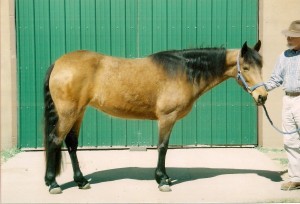
When I talked to this little girl a few days ago, it was hard to even get her to open up at first. She was very mistrusting and fearful, so having someone start talking to her who she couldn’t see was a pretty scary thing. She never did reveal her true, underlying personality because she was “flat” emotionally from her past experiences and dealings with humans. But she did show me lots of mental pictures and convey lots of feelings and ideas about why she behaves as she does.
I was called in to talk to this four-year-old filly because she spooked, shied, bolted, and bit—to the extreme. She had been bought from two “horse traders” not too many months ago, as a three-year-old who had been started at two, and nothing more was known about her background. Her new owner was very badly injured in an accident soon after getting her, when the filly spooked and bolted out from under her. She’d been hand-walked ever since (2-1/2 hours a day), but exhibited the same behavior even then, plus was now biting at her owner while they walked.
Not a pretty picture. Her owner was understandably afraid to ride her again, and was getting shoved and knocked around considerably by the filly during their walks. Both owner and horse were now afraid, so the filly had no strong leader to trust—a must in a horse’s natural life.
A four-year-old is still basically a baby horse, and if they’ve had a rough start like this girl, that young age is doubly stacked against them. This filly did show me that she had once been a normal, happy, frolicking foal, which gave me hope that that basic personality could still be resurrected. She showed me a traumatic weaning, very rough handling, and that she had extreme pain and restriction in her neck, which seemed to cut off neurological and circulatory function to the extent that her peripheral vision was restricted. So things coming into her vision “from the wrong place,” suddenly and unexpectedly, caused much of her spooking. Horses, being prey animals, can see peripherally almost all the way behind them, and that’s where predators come from. So it’s no wonder she freaked out all the time. And she said she was biting because her head was being jerked on, and it hurt!
Her owner, who had never consulted with an animal communicator before, and who was a novice horse-person, wanted me to explain things to the filly and simply tell her how she needed to behave. Unfortunately, it’s not that simple, though many people think it must be. It is assumed that if you can talk to an animal, you can just tell them what to do, how to be, not to be afraid, etc. No. You can’t override fear or pain via intellectual explanation. I have a bad back, and if someone told me to simply ignore the pain and carry on normally when I’m in the middle of an extreme episode, I would think they were both nuts and lacking compassion. I think it’s the same with animals. They might hear us tell them “everything is okay,” but until we can provide concrete help that engenders trust and relief, no change will occur.
For this baby I recommended much shorter walks in-hand, a non-invasive technique of body work called Ortho-Bionomy, and trainer Carolyn Resnick’s at-liberty approach designed to appeal to a horse in the horse’s own “language,” thereby building trust and confidence in both horse and owner.
When I have a session like this, no matter how detached and emotionally clear I try to stay, it always pains me to have to sign off, knowing that things could go either way. Sometimes I get feedback later; sometimes I don’t. And horses like this filly, who are in a state of pain and mistrust, are dangerous animals who often end up being passed around and suffering more and more abuse due to lack of understanding.
I hope and pray in this case that this little girl gets the help she needs, and that her human companions won’t continue to write off her behavior as intentional aggression.
To Geld or Not to Geld – That is the Question
At least it is the question for many horse owners and lovers. Lots of people will want to shoot me for this, but I think there is a case to be made for leaving an animal in tact. But it depends on many things: the breed, the situation, the animal’s health and genetic make-up, and more. Don’t get me wrong. Being as involved with the local animal shelter as I am, and seeing the huge numbers of unwanted dogs, cats, and horses that meet sad ends, I’m all for rounding them up and getting them all “fixed” and then adopted out into perfect homes.
But still, I think there IS a case to be made for the occasional exception.
Take Tornado, “Nado” for short, a 13-year-old stallion I talked to recently because his owner was in a terrible quandary about whether to geld him or not. Nado is exceptional in many ways: strongly bred, highly intelligent, and extremely skilled — he was a movie star in his younger years and in fact starred in The Legend of Zorro. So, as horses go, Nado is an outstanding example of his species. Yet Mary, Nado’s owner, felt he might have a happier life if gelded, because his management wouldn’t have to be so strict.
Nado talked to me about many things and was highly aware, on what I call a soul level. Our session was detailed and lengthy, and he showed me many past life scenes as well. On the question at hand – gelding – he was adamant in his opinion: ABSOLUTELY NOT! At least not any time soon. And he was very specific and eloquent in his reasoning. I include a part of that conversation here, exactly as it came across, with full permission from Nado and Mary. Nado’s actual words are in quotes, other impressions he sent me are in parentheses:
(He takes his time. He is reflecting and shows me that there are so many nuances to this question, he is simply sorting out the most important aspects and how to put them.) “Well first, I am well acquainted with this practice in the equine industry, and I do understand it.” (He shows me there has been much unreliable and irresponsible breeding of his kind, which is a horrible affront to the species, and for this reason alone gelding can be justified.) “Given that trend, it is of utmost importance that those among us who DO have the proper understanding and genetics to improve the ‘race’ be allowed to do so. It is the only way to preserve the better aspects of the species.” (He shows me then that he has so much to offer, and how this can continue down into time if he is allowed to continue siring offspring.)
This is just a short clip from our conversation, but I think it brings across the integrity and depth of thinking and feeling that many of our animal friends are capable of. As for the outcome with Nado, we worked on possible lifestyle options that would offer Nado more fulfillment, and Mary is going to take things one step at a time. For now, she is honoring Nado’s choice to stay in tact.
I concur. And I’m sure my friend Christina Savitsky, a therapeutic riding instructor, does too, as she recently took one of Nado’s offspring, a 2-year-old mare, to train as her personal ranch and teaching horse, and she reports almost daily how amazing this little filly is!
So, still, I do think there is a case to be made, now and again, for allowing certain individuals among ALL species to procreate, not just us humans . . . who often do so as irresponsibly as a puppy mill.
Riding With a Bad Back

My riding boots. Can you guess which leg I ride with? Can you imagine how much attention and care it must take for a horse to adapt to a one-sided rider? Poor Bella!
I was cleaning house today and as I was moving these riding boots (pictured left) in order to sweep under them, I was shocked to notice the difference in “dirt pattern” on them. Notice the right boot has dirt and horse sweat ground into the calf whereas the left boot shows none in this area.
I just stood there staring, This really brought home for me what I have been living with for at least the last 5 or 6 years, probably longer, and got me to wondering how it must have affected Bella, my main steady mount for all those years. As recently as 3-1/2 years ago I realized something must be wrong, because the back of my saddle always slipped to the right plus I had a lot of body pain while riding. Then I had a bad slip and fall not quite 3 years ago (not horse related) that took things over the edge.
What I learned from x-rays, due to complications from that fall, was that I not only had damaged nerves and discs, but a very marked curvature of the spine (scoliosis) which was no doubt at the seat of the earlier problems I had been noticing way before the fall. Other x-rays showed my right leg is anatomically shorter than my left. Not much, but a bit . . . and every little bit counts in body balance.
It took me quite a while to get back in the saddle after my fall. Oh I would get on, but after 5 or 10 minutes I was hurting so bad I had to get off. But I really, really wanted to be able to ride again, both in the ring and out on the trail.
So a year ago, when I heard about a certain therapeutic riding instructor in my area, Christina Savitsky, I had one of those magical ‘aha’ moments where you just “know” something is right — that she was the person who could help me ride again.
I called Christina, and the story gets better from that point on. She arrived on that first day with a big smile on her face, a huge cowboy hat on her head to shade her lovely face from our intense New Mexico sun, and an adorable 15-month-old hanging onto her back like a baby monkey. Before mounting up we started talking, and I told her what had happened: the fall, the scoliosis, etc., and before I could even get half of it out she said, “I can see it.” I said, “What?” She said, “I already saw it, when you had your back to me.” I was impressed.

Christina, schooling me in the ring in one our first sessions together, with little Mesa Ray hanging off her back.
Christina already had years under her belt of helping people like me, many with much worse conditions, so as far as she was concerned I was “not a problem.” We got me up on the horse and she began instructing me, gently and positively, in how to reposition my pelvis and back so as to sit in a more comfortable position. She also raised my stirrups so far up that I felt like I was sitting in a rocking chair (and kinda silly . . . but that takes pressure off the lower back, my problem area).
I can ride an hour and a half now (haven’t tested longer), and I give all the credit to Christina. And I hope to do much more in the coming year or two.
I guess the message here — if anyone else with body problems is reading this blog — is to seek help. Don’t be shy or self-conscious. There are millions of people like us who have such problems! Find a kind someone who has experience and understands your problems and can help you “adjust” your body in such a way as to be successful in the saddle once again. Though I still am not a heavy rider as compared with most, and I ride only for pleasure, I am so very thankful I found the one angel disguised as a therapeutic-riding-instructor-cowgirl who could help me, Leta, get back to what I love so much!
So to all of you with pain and body problems: Find your own riding angel! He or she is out there!
*********************************************************************************************************
If you enjoyed this post and would like to read more about Christina and what makes a good riding instructor, go HERE!
Native Grasses or Premium Horse Hay – Which is Best?
In my book, native grasses absolutely rule! If they are truly “native” and growing randomly and wildly, they present a smorgasborg of variety and nutrition for the ambling equine. In the wild, a horse may travel up to 20 miles a day, taking a bite or two here, moving a good distance, then sampling a few more bites there. He hardly ever stands still, and unlike us, is meant to “eat on the run” (or walk). Imagine not only the number of grasses that horse is getting, but also the varying nutrients the soil in each area provides!
Unfortunately, very few horses these days have access to a natural grazing pattern on native grasses. It’s sad, but it is true. We have some wonderful hay growers, thank goodness, but most hays are overfertilized to keep out weeds or add nutrients, so they are often overly rich or way off balance in terms of the minerals they contain.
If your horse has 10 different grasses and “weeds” to munch on, he will always know which ones he needs and will choose those first, until he’s had his fill of them. What better method for fulfilling your horse’s nutritional requirements? So for me? I’d always choose native grasses over hay, whenever possible.
In Texas my horses had access to about 500 acres 24/7 so had the great fortune to be able to pick and choose amongst the local fodder. I fed hay sometimes too, especially during drought or winter months, when grass was scant, but they always seemed to find some tempting, naturally growing morsel to complete their menu.
Here in the high desert of New Mexico things are radically different. My horses have eight acres of varied terrain but not one blade of grass therein. If one errant grass seed does dare to pop its little head up, they find it immediately and it’s toast!
I am fortunate, however, in that I do have some meadowy areas where several strains of grasses and weeds grow abundantly when we have even the slightest bit of moisture. We are in the monsoon season right now, so there’s grass galore. Whenever I can, every day or two, I turn the horses out for controlled grazing periods. Usually one at a time, since my 40 acres is not totally perimeter fenced and I don’t want to have to go chasing the herd over the hills. They love their “time in the sun” and gorge on the grasses as fast as they can, probably knowing their turn will be over in an hour or so. This rotated grazing during our grassy days really helps save on hay and really amps up everybody’s nutrition.
I know we don’t all have access to grass for our horses, or we don’t have that access all the time. But if you do, ever, try to make sure your equine gets some of it. It’s the healthiest thing you can do for him, plus it makes him just feel more like a real horse because he’s doing a real horse thing – grazing!
